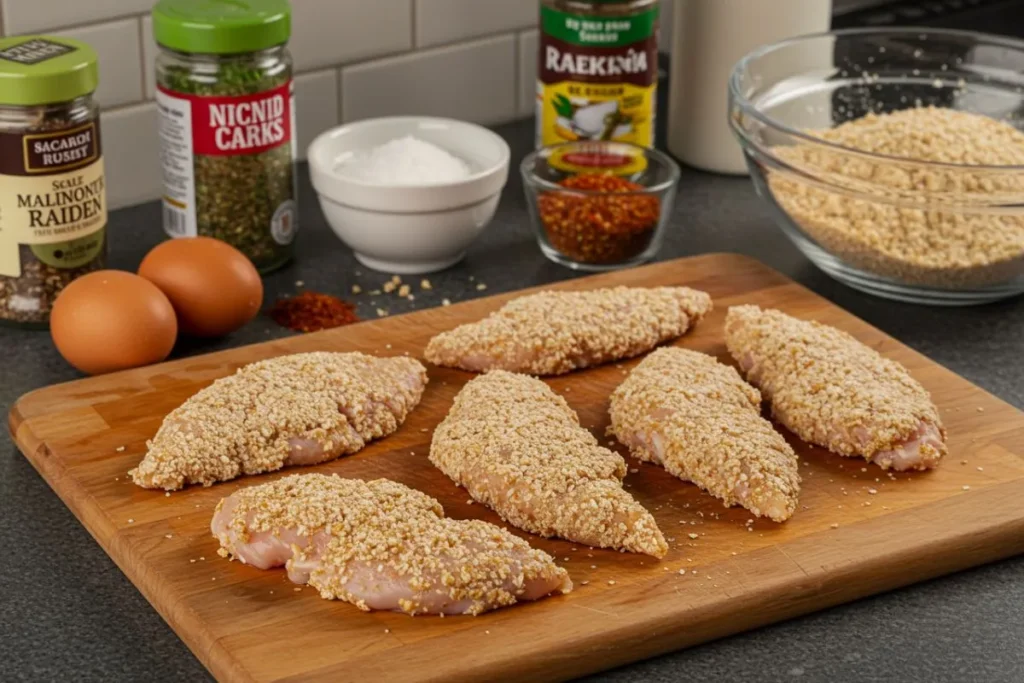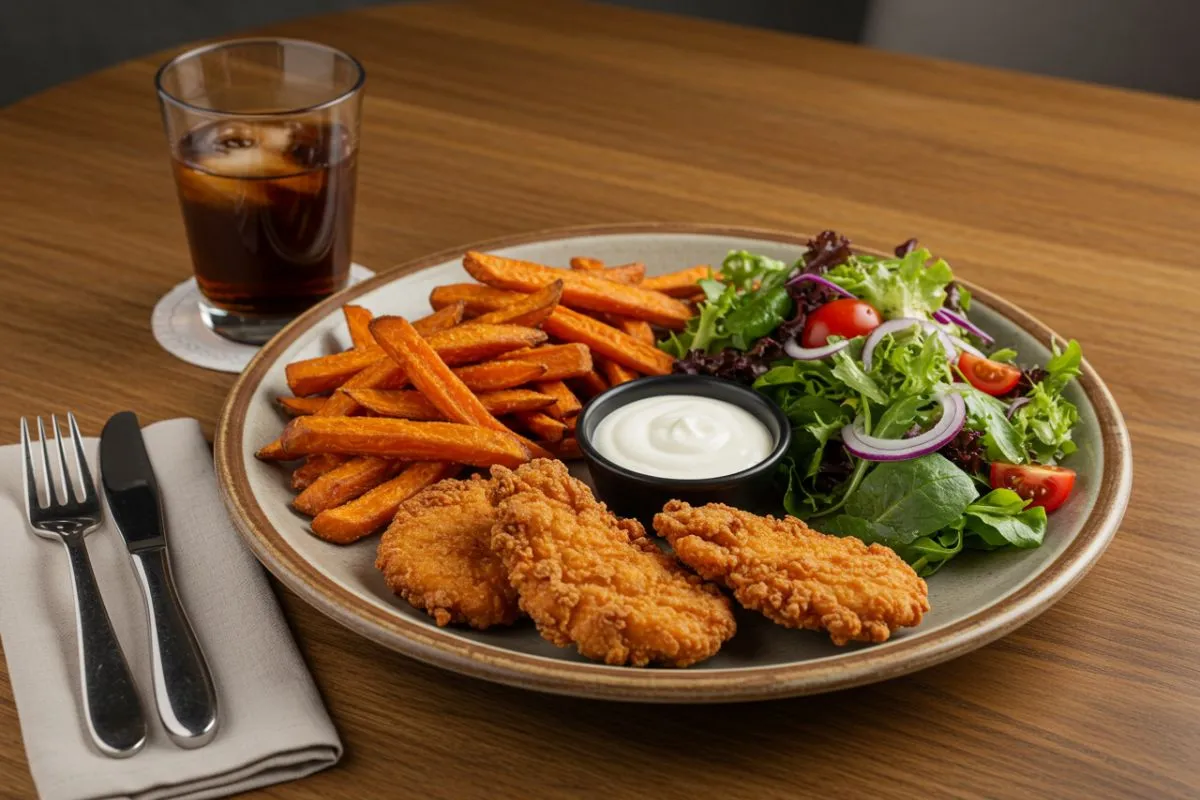Is chicken tenders and fries healthy? This beloved comfort food combination sparks much debate. While undeniably tasty, concerns often arise about their preparation methods, calorie content, and nutritional value. In this article, we’ll explore whether chicken tenders and fries can fit into a balanced diet, diving into their nutritional components, the impact of cooking techniques, and tips for enjoying them in a healthier way.
Let’s dive in and uncover whether chicken tenders and fries can truly fit into a balanced diet.
Nutritional Overview of Chicken Tenders and Fries
What Are Chicken Tenders and Fries Made Of?
Chicken tenders are typically crafted from the lean pectoral muscle of the chicken, offering a tender and juicy bite. They’re usually breaded and deep-fried, resulting in their iconic crispy coating. Meanwhile, French fries are made from potatoes, often fried in oil until golden brown. Together, these make a comforting combo with a satisfying crunch.
But the story doesn’t end there. Cooking methods and ingredient choices can vary, significantly influencing the dish’s nutritional profile.
Key Nutritional Components
When it comes to nutrition, chicken tenders and fries offer a mixed bag. On the bright side, chicken tenders are a great source of protein, providing between 20–30 grams per serving. Fries, on the other hand, are rich in carbohydrates, offering quick energy. But here’s the catch: the breading and frying process often add unwanted fats and calories.
A typical serving of chicken tenders (3–4 pieces) can pack:
- 200–400 calories, depending on size and preparation.
- 10–20 grams of fat, primarily from frying oil.
- 500–1000 milligrams of sodium, due to seasoning and breading.
As for French fries (a medium serving):
- 300–400 calories, mainly from carbs and fat.
- Around 15 grams of fat, if deep-fried.
- Moderate amounts of potassium and vitamin C from potatoes.
While the dish provides essential nutrients like protein and potassium, the high calorie, fat, and sodium content may make frequent consumption a health concern.
Check out the USDA’s nutritional facts for potatoes for more detailed information.
The Calorie Factor
Let’s face it, fried foods like chicken tenders and fries aren’t the lightest on calories. Deep-frying introduces additional fats, which can push the calorie count sky-high. If you’re aiming to manage your intake, preparation methods such as baking or air frying can make a world of difference. For instance, baking cuts back on oil, trimming excess fat while still delivering delicious flavors.
In short, chicken tenders and fries are fine in moderation, but their nutritional impact depends heavily on how they’re cooked and served. Up next, we’ll explore how various cooking methods can transform these treats into healthier options without sacrificing flavor. Stay tuned!
The Impact of Cooking Methods on Health
Deep Frying: The Pros and Cons
Deep frying is one of the most popular methods for preparing chicken tenders and fries. It delivers that irresistibly crispy exterior while keeping the chicken juicy inside. However, this method also introduces significant amounts of fat and calories. Oils like canola or vegetable oil, commonly used for frying, are calorie-dense and can contribute to higher saturated fat intake.
For example, a single serving of fried chicken tenders and fries can exceed 600 calories, making it a less-than-ideal choice for those aiming for a balanced diet. Plus, frequent consumption of fried foods has been linked to health risks like weight gain and heart issues. But let’s not dismiss deep frying entirely—when done occasionally and paired with lighter meals, it can still be part of an enjoyable lifestyle. Learn more about maintaining heart health with Hopkins Medicine’s heart-healthy eating tips.
Baking and Air Frying: Healthier Alternatives

Baking is a fantastic option for those seeking a healthier spin on chicken tenders and fries. By using minimal oil and oven heat, you can still achieve a satisfying crunch without the extra fat. Baking slashes the calorie count by about 30%, making it a win for your waistline and taste buds. For added flavor, sprinkle herbs and spices onto the breading before popping them into the oven.
Even better, air fryers have revolutionized how we enjoy fried foods. These appliances use hot air circulation to mimic deep frying, requiring little to no oil. Discover the health benefits of air frying and how it compares to traditional methods. Air-fried chicken tenders can taste just as crispy while keeping the fat content in check. Additionally, you can prepare both tenders and fries simultaneously, saving time and reducing clean-up—a tip perfect for busy weeknights!
Grilling and Other Techniques
Grilling chicken tenders is another way to keep things lean while adding a smoky, charred flavor. This method avoids breading altogether, emphasizing the natural taste of chicken. Add a marinade of olive oil, garlic, and fresh herbs to elevate the flavor. You can even pair grilled tenders with roasted sweet potato wedges for a nutrient-packed alternative to fries.
In short, switching up your cooking methods can dramatically improve the health profile of your favorite dishes. Looking for step-by-step inspiration? Check out this crispy chicken tenders and fries recipe for additional tips.
Balancing Indulgence with Healthy Choices
Portion Control and Meal Pairing
It’s no secret that portion sizes play a huge role in whether a meal is considered healthy. Check out MyPlate’s portion control tips for guidance on serving sizes. Chicken tenders and fries don’t have to be unhealthy if enjoyed in moderation. Stick to smaller servings—like three chicken tenders and a half-cup of fries—to keep your meal within a reasonable calorie range.
Pairing is key to creating balance. Add a side salad, steamed veggies, or a serving of fresh fruit to up the nutritional value of your meal. For example, a crisp green salad with a light vinaigrette can complement the richness of fried tenders and fries beautifully. By balancing your plate, you’ll feel full and satisfied without overloading on calories.
Incorporating Healthier Ingredients
Choosing the right ingredients can make all the difference. Opt for whole-grain breadcrumbs for added fiber and nutrients in your chicken tenders. Instead of white potatoes, experiment with sweet potatoes or zucchini for your fries—both are lower in calories and packed with vitamins.
Another easy change is using spices instead of salt-heavy mixes. Fresh herbs like parsley or cilantro and spices like paprika or turmeric not only boost flavor but also add healthy nutrients to your meal. Cooking with these smart swaps can make enjoying your food guilt-free.
By practicing mindful eating and tweaking your recipes, you can enjoy chicken tenders and fries as part of a nutritious and delicious lifestyle. Ready to explore more wholesome chicken recipes? Try this Marry Me Chicken Pasta for another delightful dish.
Healthier Alternatives and Recipes
Creating Healthier Chicken Tenders at Home
If you’ve ever wondered “Is chicken tenders and fries healthy?”, the answer lies in how you prepare them. Making chicken tenders at home is not only fun but also gives you control over ingredients and cooking methods. Start with lean chicken breasts or tenderloins, and swap traditional breading for whole-grain breadcrumbs or crushed nuts for added fiber and nutrients.
For a healthier twist, skip deep frying. Baking or air frying can deliver crispiness without excessive oil. Simply preheat your oven to 400°F, coat your breaded tenders lightly with cooking spray, and bake for 20–25 minutes, flipping halfway through. Want them extra golden? Broil them for an additional 2 minutes. Air fryers can achieve similar results in less time, making them a convenient option.
Pair these tenders with homemade sweet potato fries, seasoned with paprika and garlic powder, for a nutrient-rich alternative. This not only reduces calories but also boosts your intake of beta-carotene and fiber.
Substituting Fries with Nutrient-Dense Options
Classic French fries are delicious, but they’re not your only option. Why not try zucchini fries or baked carrot sticks? These alternatives are lower in carbs and calories but still satisfy that crispy craving. Coat them in breadcrumbs or Parmesan cheese for a flavorful twist.
Sweet potato fries are another good choice. Bake them with a little olive oil and sprinkle with cinnamon or chili powder for a special flavor. Learn more about the health benefits of sweet potatoes and why they’re a great alternative. These swaps add variety to your meals and make chicken tenders and fries healthier.
For even more creative ideas, check out Empress Chicken Recipe on YupRecipes—it’s a bold and flavorful alternative to standard fried dishes.
Understanding the Role of Chicken Tenders and Fries in a Balanced Diet
Can They Be Part of a Healthy Diet?
The big question remains: Is chicken tenders and fries healthy enough to include in your diet regularly? The answer largely depends on how often and how much you consume. Occasional indulgence in fried chicken and fries is fine, but making them a weekly staple may tip the balance toward unhealthy.
To keep things balanced, focus on portion control and preparation methods. Choose baked or air-fried options, and round out your plate with fresh vegetables or a light salad. This approach ensures you’re enjoying your favorite comfort foods without hurting your health goals .
The Importance of Nutritional Diversity
Variety is the spice of life—and your diet! While chicken tenders and fries can be a treat, pairing them with healthy foods helps ensure you’re getting a mix of essential vitamins and minerals. Think of meals as an opportunity to combine indulgent items with wholesome sides.
For example, grilled chicken tenders on a bed of greens or with roasted vegetables can turn the dish into a healthy, filling meal. Even regular chicken tenders can fit into a balanced diet when made carefully.
If you’re looking for more ideas to diversify your meals, consider exploring recipes like Blackened Chicken Alfredo for another exciting way to enjoy chicken in your diet.
Frequently Asked Questions (FAQs)
Is chicken tenders and fries healthy for children?
Chicken tenders and fries are undeniably popular with kids, but their healthiness depends on preparation and portion size. Homemade versions, baked or air-fried, are healthier than store-bought or deep-fried options. Pairing tenders with veggies or fruit can balance the meal, making it more nutritious without losing kid-friendly appeal.
Can I eat chicken tenders and fries on a diet?
Yes, you can enjoy chicken tenders and fries while dieting by choosing lighter cooking methods and controlling portions. Opt for baked or air-fried chicken tenders and substitute classic fries with sweet potato wedges or zucchini sticks. Moderation and mindful meal planning are key.
What are the best oils for frying chicken tenders and fries?
When frying, pick oils with high smoke points, like canola, sunflower, or peanut oil. These oils handle high heat well, helping your food cook evenly without adding bad fats.
Can chicken tenders and fries fit into a low-carb lifestyle?
Absolutely! For low-carb versions, swap the breading with almond flour or crushed pork rinds. Pair these with roasted veggies instead of fries to keep your meal flavorful yet low in carbs.
Tips for Healthier Cooking and Pairing
Healthier Cooking Methods

Preparing chicken tenders and fries at home allows you to control the ingredients and cooking methods, which can make all the difference. Opt for healthier approaches like baking or air frying to reduce fat content while still achieving that crispy texture. Using oils with a high smoke point, such as canola or sunflower oil, ensures your food cooks evenly without adding harmful trans fats.
For an even lighter option, skip the breading altogether and grill your chicken tenders. Pair these with oven-roasted sweet potato fries, seasoned with smoked paprika and a touch of garlic powder, for a flavorful twist.
Creative Pairing Ideas
Balance is key when asking “Is chicken tenders and fries healthy?” The right pairings can elevate this classic dish into a more nutritious meal. Consider adding:
- A crisp side salad with fresh greens, cucumbers, and a light vinaigrette.
- Steamed or roasted vegetables like broccoli, asparagus, or carrots.
- A small serving of quinoa or brown rice for extra fiber and protein.
These additions not only provide essential nutrients but also make your meal more filling without excess calories.
Quick Flavor Boosts
Sprinkle fresh herbs like parsley or cilantro on your chicken tenders for an instant upgrade. Experiment with dips such as yogurt-based ranch or hummus for a healthier alternative to ketchup or barbecue sauce.
By combining thoughtful cooking methods with creative pairings, you can enjoy chicken tenders and fries as part of a balanced and delicious lifestyle.
Making Chicken Tenders and Fries More Nutritious for Families
Healthy Upgrades for Busy Families
When feeding a family, balancing taste, convenience, and nutrition can feel like a juggling act. The good news? With small tweaks, chicken tenders and fries can be transformed into a healthier meal that everyone loves.
Start with the chicken. Instead of heavily processed store-bought options, prepare your own tenders using fresh chicken breasts. For breading, consider whole-grain breadcrumbs or crushed cornflakes for extra crunch and nutrients. Air frying or baking ensures they remain crispy without the added grease from deep frying.
For fries, skip the traditional white potatoes and try sweet potatoes or carrots. These alternatives are nutrient-rich and naturally sweet, which kids often enjoy. Bake them with a drizzle of olive oil and sprinkle with your favorite spices for a flavorful twist.
Encouraging Healthy Habits at the Table
Serving chicken tenders and fries alongside healthier sides can subtly introduce your family to a more balanced diet. A side of steamed broccoli or a vibrant fruit salad adds color and nutrition to the plate. Additionally, offering dips like guacamole or Greek yogurt-based ranch instead of ketchup boosts the meal’s nutritional value.
Family meals are a great chance to teach portion control. Serve smaller amounts of tenders and fries, leaving space for healthier options. This helps kids and adults enjoy their favorite comfort foods without eating too much.
For more family-friendly recipes, check out our Sweet Hawaiian Crockpot Chicken Recipe—it’s a flavorful option the whole family will adore.
Final Thoughts on Is Chicken Tenders and Fries Healthy
When it comes to answering “Is chicken tenders and fries healthy?”, it’s all about perspective. While traditional recipes may be calorie-dense and high in fat, thoughtful preparation and portion control can make this dish part of a balanced diet.
Opting for healthier cooking methods like air frying or baking and pairing with nutrient-rich sides can turn chicken tenders and fries from indulgent to balanced. Remember, the occasional indulgence is perfectly fine—enjoying your favorite foods in moderation keeps eating both enjoyable and sustainable.
The key takeaway? With a little creativity in the kitchen, you can savor chicken tenders and fries guilt-free. Whether you’re preparing them for yourself or your family, making mindful choices allows you to enjoy the best of both worlds: flavor and health.
Looking for more inspiration? Explore our recipe for Blackened Chicken Alfredo for a bold and satisfying dish that’s sure to impress.

